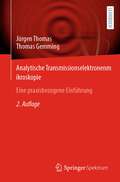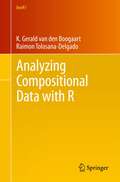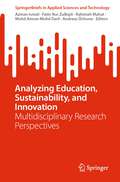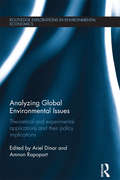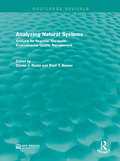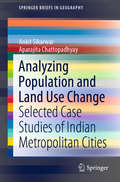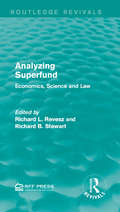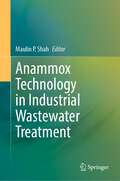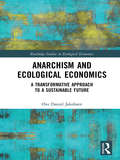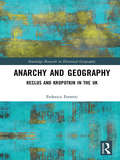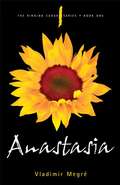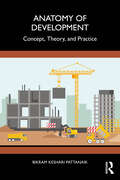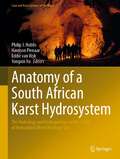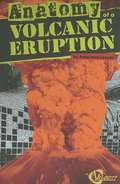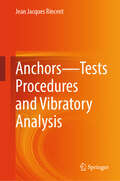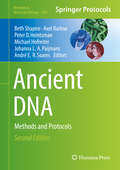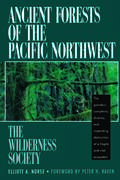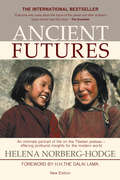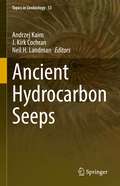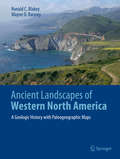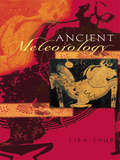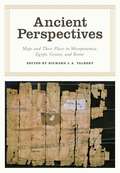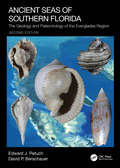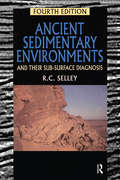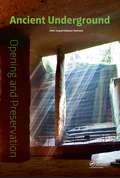- Table View
- List View
Analytische Transmissionselektronenmikroskopie: Eine praxisbezogene Einführung
by Jürgen Thomas Thomas GemmingDas Buch wendet sich an alle, egal ob im Studium, in technischen Berufen, oder in der Wissenschaft, die die sich für die analytische Transmissionselektronenmikroskopie interessieren und einen Überblick über diese Methode erhalten möchten. Insbesondere betrifft dies Personen, die an einem Transmissionselektronenmikroskop arbeiten wollen oder müssen, die aber noch keine spezielle elektronenmikroskopische Ausbildung durchlaufen haben. Das Buch basiert auf den Erfahrungen der Autoren bei der Unterrichtung von Studierenden, Promovierenden und in technischen Berufen Tätigen. Der Überblick über die analytische Transmissionselektronenmikroskopie umfasst die Schwerpunkte Optische Abbildung, Elektronenwellen, magnetische Linsen, Abbildungsfehler, Aufbau eines Transmissionselektronenmikroskops, Präparation dünner Proben, Justage des Mikroskops, Elektronenbeugung, Kontrastentstehung, Höchstauflösungselektronenmikroskopie, Rastertransmissionselektronenmikroskopie sowie Analytik mittels energiedispersiver Röntgenspektroskopie und Elektronenenergieverlust-Spektroskopie. Ein mathematischer Anhang erklärt grundlegende Formalismen zur Thematik.
Analyzing Compositional Data with R (Use R!)
by K. Gerald van den Boogaart Raimon Tolosana-DelgadoThis book presents the statistical analysis of compositional data sets, i.e., data in percentages, proportions, concentrations, etc. The subject is covered from its grounding principles to the practical use in descriptive exploratory analysis, robust linear models and advanced multivariate statistical methods, including zeros and missing values, and paying special attention to data visualization and model display issues. Many illustrated examples and code chunks guide the reader into their modeling and interpretation. And, though the book primarily serves as a reference guide for the R package "compositions," it is also a general introductory text on Compositional Data Analysis. Awareness of their special characteristics spread in the Geosciences in the early sixties, but a strategy for properly dealing with them was not available until the works of Aitchison in the eighties. Since then, research has expanded our understanding of their theoretical principles and the potentials and limitations of their interpretation. This is the first comprehensive textbook addressing these issues, as well as their practical implications with regard to software. The book is intended for scientists interested in statistically analyzing their compositional data. The subject enjoys relatively broad awareness in the geosciences and environmental sciences, but the spectrum of recent applications also covers areas like medicine, official statistics, and economics. Readers should be familiar with basic univariate and multivariate statistics. Knowledge of R is recommended but not required, as the book is self-contained.
Analyzing Education, Sustainability, and Innovation: Multidisciplinary Research Perspectives (SpringerBriefs in Applied Sciences and Technology)
by Andreas Öchsner Azman Ismail Mohd Amran Mohd Daril Fatin Nur Zulkipli Rahimah MahatThis book describes a diverse array of studies unravelling the intricate interplay of education, sustainability, and organizational dynamics. From innovative teaching methodologies to sustainability trends and the pandemic's impact, this compendium offers a rich tapestry of insights. This book traverses through a compendium of studies that intricately dissect the synergy between education, sustainability, and organizational dynamics. This book is ideal for academics, practitioners, and curious minds seeking a deeper understanding of these vital contemporary forces.
Analyzing Global Environmental Issues: Theoretical and Experimental Applications and their Policy Implications (Routledge Explorations in Environmental Economics #39)
by Ariel Dinar Amnon RapoportThe existence of environmental dilemmas and political conflicts leads us to appreciate the need for individuals and groups to behave strategically in order to achieve their goals and maintain their wellbeing. Global issues such as climate change, resource depletion, and pollution, as well as revolts and protests against corporations, regimes, and other central authorities, are the result of increased levels of externalities among individuals and nations. These all require policy intervention at international and global levels. This book includes chapters by experts proposing game theoretical solutions and applying experimental design to a variety of social issues related to global and international conflicts over natural resources and the environment. The focus of the book is on applications that have policy implications, relevance and, consequently, could lead to the establishment of policy dialogue. The chapters in the book address issues that are global in nature, such as international environmental agreements over climate change, international water management, common pool resources, public goods, international fisheries, international trade, and collective action, protest, and revolt. The book’s main objective is to illustrate the usefulness of game theory and experimental economics in policy making at multiple levels and for various aspects related to global and international issues. The subject area of this book is already widely taught and researched, but it continues to gain popularity, given growing recognition that the environment and natural resources have become more strategic in human behavior.
Analyzing Natural Systems: Analysis for Regional Residuals-Environmental Quality Management (Routledge Revivals)
by Daniel J. Basta Blair T. BowerThis report was undertaken on local, regional, state and federal levels in the United States to analyse the impact residuals have on environmental quality and to emphasise the need for Residuals- Environmental quality management (REQM). Originally published in 1982, this study brings together information on approaches for analysing natural systems and which factors to consider when choosing an approach. This title will be of interest to students of environmental studies as well as professionals and policy makers.
Analyzing Population and Land Use Change: Selected Case Studies of Indian Metropolitan Cities (SpringerBriefs in Geography)
by Ankit Sikarwar Aparajita ChattopadhyayThis multidisciplinary book discusses and scientifically analyzes issues related to population, land use/cover (LULC) and environmental transformations in the seven most populated cities in India: Delhi, Mumbai, Kolkata, Bangalore, Chennai, Hyderabad and Ahmedabad. To do so, it closely examines and compares the trends in selected population parameters, including total population, total number of households, population density, population growth rate, percent of total population in slums and intercensal net migration over the past two decades. Presenting the changes in various LULC categories (built-up land, forest cover, agricultural land, fallow land and water bodies) using the supervised classification of Landsat TM-5 images, it assesses the impact of population and LULC on the maximum and minimum temperatures and average annual rainfall in these regions. The book is a valuable resource for researchers and academics in the areas of sustainability, population and development, and environmental studies as well as those in NGOs and humanitarian sectors working in the areas of sustainable development and environment.
Analyzing Superfund: Economics, Science and Law (Routledge Revivals)
by Richard B. Stewart Richard L. ReveszOriginally published in 1995, Analyzing Superfund outlines the key issues of the superfund reauthorization debate in the United States. The Superfund law faced criticism for being wasteful, inefficient and expensive. These papers sought to shed light on this argument in relation to clean-up standards, the liability regime, transaction costs and natural resource damage. This title will be of interest to students of Environmental Studies and professionals
Anammox Technology in Industrial Wastewater Treatment
by Maulin P. ShahAmmonia in wastewater causes the eutrophication of water bodies and the subsequent depletion of dissolved oxygen. In addition, certain forms of nitrogen such as ammonia, nitrite, and nitrate are highly toxic to aquatic life. Although there are several biological and physical–chemical techniques for the removal of ammoniacal nitrogen compounds, including air stripping and breakpoint chlorination, which have been widely applied, a microbiological or microbe-based approach is attractive because it is based on sustainable technologies. In this regard, ammonia-oxidizing bacteria have recently gained great interest, specifically in wastewater treatment plants for the removal of ammoniacal nitrogen especially, owing to its relatively low capital cost, eco-friendliness, and high efficiency when compared with conventional cleanup technologies. This book provides specific and advanced knowledge on the microbial ecology of ammonia-oxidizing bacteria and their diversity and functions in the treatment of toxic pollutants present in wastewater. The book thus serves as a valuable resource for engineers, scientists, and managers who require an excellent introductory and advanced knowledge of the field, professionals who are working or interested in the environmental microbiology or bioremediation field, and students learning about environmental biotechnology and microbiology.
Anarchism and Ecological Economics: A Transformative Approach to a Sustainable Future (Routledge Studies in Ecological Economics)
by Ove Daniel JakobsenAnarchism and Ecological Economics: A Transformative Approach to a Sustainable Future explores the idea that anarchism – aimed at creating a society where there is as much freedom in solidarity as possible – may provide an ideal political basis for the goals of ecological economics. It seems clear that it is going to be impossible to solve the problems connected to environmental degradation, climate change, economic crashes and increasing inequality, within the existing paradigm. The anarchist aims of reducing the disparities of rank and income in society and obtaining a high standard of living within environmentally sound ecosystems chime well with the ecological economists’ goal of living within our environmental limits for the betterment of the planet and society. The book refers to the UN’s sustainability development goals, and the goals expressed in the Earth Charter, viewing them through an anarchist’s lens. It argues that in order to establish ecological economics as a radical new economy right for the 21st century, neoliberal economics needs to be replaced. By connecting ecological economics to a solid philosophical tradition such as anarchism, it will be easier for ecological economics to become a far more potent alternative to “green” economic thinking, which is based on, and supports, the dominant political regime. Innovative and challenging, this book will appeal to students and scholars interested in economics and the politics surrounding it.
Anarchy and Geography: Reclus and Kropotkin in the UK (Routledge Research in Historical Geography)
by Federico FerrettiThis book provides a historical account of anarchist geographies in the UK and the implications for current practice. It looks at the works of Frenchman Élisée Reclus (1830–1905) and Russian Pyotr Kropotkin (1842–1921) which were cultivated during their exile in Britain and Ireland. Anarchist geographies have recently gained considerable interest across scholarly disciplines. Many aspects of the international anarchist tradition remain little-known and English-speaking scholarship remains mostly impenetrable to authors. Inspired by approaches in historiography and mobilities, this book links print culture and Reclus and Kropotkin’s spheres in Britain and Ireland. The author draws on primary sources, biographical links and political circles to establish the early networks of anarchist geographies. Their social, cultural and geographical context played a decisive role in the formation and dissemination of anarchist ideas on geographies of social inequalities, anti-colonialism, anti-racism, feminism, civil liberties, animal rights and ‘humane’ or humanistic approaches to socialism. This book will be relevant to anarchist geographers and is recommended supplementary reading for individuals studying historical geography, history, geopolitics and anti-colonialism.
Anastasia (The Ringing Cedars Series #1)
by Vladimir Megré John Woodsworth Leonid SharashkinYou are about to read some of the most shocking revelations to appear in thousands of years of human history - so significant that they are changing the course of our destiny and rocking scientific and religious circles to the core.
Anatomy of Development: Concept, Theory, and Practice
by Bikram PattanaikThis book details the fundamentals of development studies by adopting a multi-disciplinary approach. It presents a balanced mix of economic, social, political, cultural and administrative premises of development and analyzes its theoretical and practical dimensions. It also provides insight into the role of the stakeholders of development in different sectors.The volume provides a holistic understanding of development, effectively demonstrating how it differs from economic growth. Beginning with development theories, paradigms and actors involved in the development process, this book goes on to explain the concepts of development administration, development governance, development planning, development management and development communication. One of the fundamental components of the book is the elucidation of Development Theories – classical, neoclassical, developmental and heterodox theories essential to the discipline of “development”.This book will be useful to undergraduate and postgraduate students, researchers, teachers of development studies, economics, sociology, political science, and public administration. It will also be useful to administrators and development administration officials of state and central governments, planners, policymakers and people working in NGOs, in addition to corporate sector functionaries dealing with corporate social responsibilities and those handling developmental issues and challenges.
Anatomy of a South African Karst Hydrosystem: The Hydrology and Hydrogeology of the Cradle of Humankind World Heritage Site (Cave and Karst Systems of the World)
by Philip J. Hobbs Harrison Pienaar Eddie Van Wyk Yongxin XuThis book combines the results of the research activities in the assessment of water resources environment and an integrated water resource monitoring program to support preservation efforts of the aquatic environment of the Cradle of Humankind (COH), World Heritage Sites. A poor understanding of the surface and groundwater resources of the COH property has precipitated often alarmist reporting in the media regarding the negative impacts associated with various sources of poor quality water. The most notable of these is the acid mine drainage threat to karst ecosystems and fossil sites across the property. These circumstances have generated wide and considerable concern for the preservation of the UNESCO-inscribed fossil sites and integrity of the water resources of the property.
Anatomy of a Volcanic Eruption
by Amie Jane LeavittDescribes volcanic eruptions, including their causes, prediction, and effects.
Anchors—Tests Procedures and Vibratory Analysis
by Jean Jacques RincentThis book follows: Ground Anchors: Tension Force Vibratory Analysis JJ Rincent Springer Sept 2024. This new book is a summary of experience gained from the analysis of over 24 000 test curves obtained from 3000 ground anchors analysis. It provides practical feedback on the complexity of non-destructive testing. The test equipment, the rules to obtain interpretable acquisition results. The examples come from trials carried out in Brazil over the last 5 years and finally, the test methodology adopted for this experiment. These tests are generally carried out on ground anchors using strands as reinforcement or rebars several decades old. Information on their length and initial tension force is often non-existent after 40 years. That's why these vibration analysis tests provide the answers and information needed for stability and maintenance diagnostics. The examples chosen concern ground anchors equipped with bars, strands and also for nails, passive ground anchors and micro piles. Tests on prestressed dowels are described, and a test on a reinforcing bar linked to the construction of an early 16th century castle will be carried out. As a reminder that these tests results lead to define the total length of the tie bar, the free length, the diameter of the tie bar, i.e. the reinforcement with its cement grout, and finally the tension force at the time of testing. These data are essential for assessing the stability of retaining walls stabilised by tie rods. It should be stated that static tests, which are difficult to carry out at height, provide no information on lengths and run the risk of breaking old tie rods. All the tests carried out are used to construct the test method that can be adopted, taking into account the feedback acquired from thousands of static tests. For retaining structures and tie rods in particular, access to the head of the tie rods must be preserved in order to: - carry out inspection tests - re-tension the tie rods, if necessary - while protecting them from corrosion. Meeting these conditions means implementing sustainable maintenance of the structures. This test method is a diagnostic tool for ground anchors used by managers of retaining structures to design maintenance projects. The final aim is to increase the durability of the retaining structures. The tests proposed and explained using numerous examples and finally to propose a methodology for carrying out vibration analysis tests on ground anchors, as well as a framework for their interpretation.
Ancient DNA: Methods And Protocols (Methods In Molecular Biology Series #840)
by Michael Hofreiter Beth Shapiro Axel Barlow Peter D. Heintzman Johanna L. A. Paijmans André E. R. SoaresThis fully updated second edition explores protocols that address the most challenging aspects of experimental work in ancient DNA, such as preparing ancient samples for DNA extraction, the DNA extraction itself, and transforming extracted ancient DNA molecules for sequencing library preparation. The volume also examines the analysis of high-throughput sequencing data recovered from ancient specimens, which, because of the degraded nature of ancient DNA and common co-extraction of contaminant DNA, has challenges that are unique compared to data recovered from modern specimens.Written in the highly successful Methods in Molecular Biology series format, chapters include introductions to their respective topics, lists of the necessary materials and reagents, step-by-step, readily reproducible laboratory protocols, and tips on troubleshooting and avoiding known pitfalls. <P><P> Authoritative and cutting-edge, Ancient DNA: Methods and Protocols, Second Edition aims to serve both experts and beginners by presenting protocols in a manner that makes them easily accessible for everyday use in the lab.
Ancient Forests of the Pacific Northwest
by Peter H. Raven The Wilderness Society Elliott A. NorseAncient Forests of the Pacific Northwest provides a global context for what is happening in the Pacific Northwest, analyzing the remaining ancient forest and the threats to it from atmospheric changes and logging. It shows how human tampering affects an ecosystem, and how the Pacific Northwest could become a model for sustainable forestry worldwide.
Ancient Futures, 3rd Edition
by Helena Norberg-Hodge H.H. the Dalai LamaA moving portrait of tradition and change in Ladakh, or “Little Tibet,” Ancient Futures is also a scathing critique of the global economy and a rallying call for economic localization. When Helena Norberg-Hodge first visited Ladakh in 1975, she found a pristine environment, a self-reliant economy and a people who exhibited a remarkable joie de vivre. But then came a tidal wave of economic growth and development. Over the last four decades, this remote Himalayan land has been transformed by outside markets and Western notions of “progress.” As a direct result, a whole range of problems—from polluted air and water to unemployment, religious conflict, eating disorders and youth suicide—have appeared for the first time. Yet this is far from a story of despair. Social and environmental breakdown, Norberg-Hodge argues, are neither inevitable nor evolutionary, but the products of political and economic decisions—and those decisions can be changed. In a new Preface, she presents a kaleidoscope of projects around the world that are pointing the way for both human and ecological well-being. These initiatives are the manifestation of a rapidly growing localization movement, which works to rebuild place-based cultures—strengthening community and our connection with nature. Ancient Futures challenges us to redefine what a healthy economy means, and to find ways to carry centuries-old wisdom into our future. The book and a related film by the same title have, between them, been translated into more than 40 languages.
Ancient Hydrocarbon Seeps (Topics in Geobiology #50)
by Neil H. Landman Andrzej Kaim J. Kirk CochranThis volume details the function of hydrocarbon seeps, their evolution over time, the most important seep occurrences and the fauna present in ancient hydrocarbon seeps. While several publications exist that cover modern seeps and vents, fossil seeps only constitute a small component of the literature. As such, many geologists, stratigraphers and paleontologists, as well as undergraduates and graduate students, are not very familiar with ancient hydrocarbon seep deposits and their associated fauna. This text is the first to comprehensively discuss the nature of such animal groups and how to recognize them. In addition to summarizing available knowledge on these topics for specialists in the field, this book offers the background needed to be of use to students as well as the wider community of geologists and paleontologists.
Ancient Landscapes of Western North America: A Geologic History with Paleogeographic Maps
by Ronald C. Blakey Wayne D. RanneyAllow yourself to be taken back into deep geologic time when strange creatures roamed the Earth and Western North America looked completely unlike the modern landscape. Volcanic islands stretched from Mexico to Alaska, most of the Pacific Rim didn’t exist yet, at least not as widespread dry land; terranes drifted from across the Pacific to dock on Western Americas’ shores creating mountains and more volcanic activity. Landscapes were transposed north or south by thousands of kilometers along huge fault systems. Follow these events through paleogeographic maps that look like satellite views of ancient Earth. Accompanying text takes the reader into the science behind these maps and the geologic history that they portray. The maps and text unfold the complex geologic history of the region as never seen before.
Ancient Meteorology (Sciences of Antiquity)
by Liba TaubThe first book of its kind in English, Ancient Meteorology discusses Greek and Roman approaches and attitudes to this broad discipline, which in classical antiquity included not only 'weather', but occurrences such as earthquakes and comets that today would be regarded as geological, astronomical or seismological. The range and diversity of this literature highlights the question of scholarly authority in antiquity and illustrates how writers responded to the meteorological information presented by their literary predecessors. Ancient Meteorology will be a valuable reference tool for classicists and those with an interest in the history of science.
Ancient Perspectives: Maps and Their Place in Mesopotamia, Egypt, Greece and Rome
by Richard J. A. TalbertAncient Perspectives encompasses a vast arc of space and time--Western Asia to North Africa and Europe from the third millennium BCE to the fifth century CE--to explore mapmaking and worldviews in the ancient civilizations of Mesopotamia, Egypt, Greece, and Rome. In each society, maps served as critical economic, political, and personal tools, but there was little consistency in how and why they were made. Much like today, maps in antiquity meant very different things to different people. Ancient Perspectives presents an ambitious, fresh overview of cartography and its uses. The seven chapters range from broad-based analyses of mapping in Mesopotamia and Egypt to a close focus on Ptolemy's ideas for drawing a world map based on the theories of his Greek predecessors at Alexandria. The remarkable accuracy of Mesopotamian city-plans is revealed, as is the creation of maps by Romans to support the proud claim that their emperor's rule was global in its reach. By probing the instruments and techniques of both Greek and Roman surveyors, one chapter seeks to uncover how their extraordinary planning of roads, aqueducts, and tunnels was achieved. Even though none of these civilizations devised the means to measure time or distance with precision, they still conceptualized their surroundings, natural and man-made, near and far, and felt the urge to record them by inventive means that this absorbing volume reinterprets and compares.
Ancient Seas of Southern Florida: The Geology and Paleontology of the Everglades Region
by Edward J. Petuch David P. BerschauerThe authors have done an outstanding job of compiling decades of data collected by their own field reconnaissance and other geoscientists… This represents a significant contribution to the understanding of the development of the Florida carbonate platform, and it will assist other disciplines as they strive for better understanding of our groundwater resources, aquifer characterizations, paleoenvironmental interpretations, and historical/educational geology programs.Walt Schmidt, Florida State Geologist & Chief, Florida Geological Survey, USA (praise for the first edition)Painting a complete picture of the history of the Everglades, Ancient Seas of Southern Florida: The Geology and Paleontology of the Everglades Region, Second Edition provides an overview of the geology, paleontology, and paleoceanography of the region. It emphasizes the upper 300m of the geologic framework of the area and gives insight into the local stratigraphy, geomorphology, lithology, and historical geology. Designed to be a field guide as well as a reference, the book is illustrated in full color with brand new photographs of exposed geologic sections, stratotype localities, collection sites, and details of interesting fossil beds.In this book, the authors illustrate almost 800 of the most important and diagnostic stratigraphic index fossils found in these beds, including over 50 species of corals and almost 700 species of mollusks, along with echinoderms, crustaceans, echinoids, petrified wood, and aquatic vertebrates. A new edition of The Geology of the Everglades and Adjacent Areas, it contains larger images of fossil shells, corals, and echinoderms and includes new updated geological data and concepts, as well as an expanded iconography of stratigraphic index fossils. Based on the data gleaned from these fossils, it also offers a series of geomorphological visualizations, showing the possible appearances of the Florida Peninsula during the times when it was covered by tropical seas, from the Oligocene to the late Pleistocene.This second edition provides a new perspective on both the historical geology of southern Florida and the evolution of one of America’s most beautiful natural treasures, the Everglades.
Ancient Sedimentary Environments: And Their Sub-surface Diagnosis
by Selley, Richard C.This edition retains the case history approach to emphasize the subsurface diagnosis of environments using seismic and geophysical well logs and their application to petroleum exploration and production. This book should be of interest to undergraduates in sedimentology and petroleum geology.
Ancient Underground Opening and Preservation: Proceedings of the International Symposium on Scientific Problems and Long-term Preservation of Large-scale Ancient Underground Engineering (23-26 October 2015, Longyou, Zhejiang, China)
by Zhifa Yang Chikaosa TanimotoAncient Underground Opening and Preservation contains 59 papers presented at the International Symposium on Scientific Problems and Long-term Preservation of Largescale Ancient Underground Engineering (Longyou, China, 23-26 October 2015). The contributions focus on scientific and technical issues related to long-term preservation of large-scale anc
